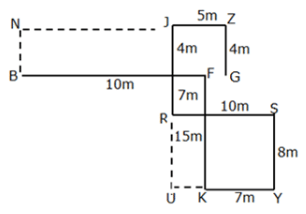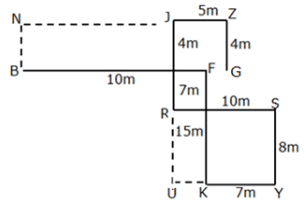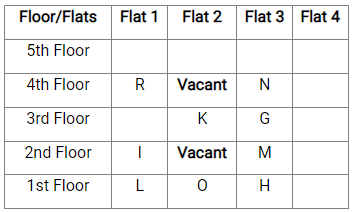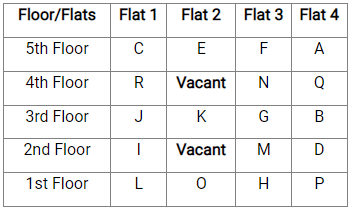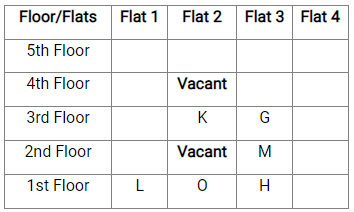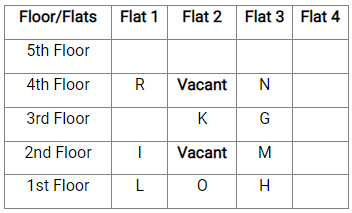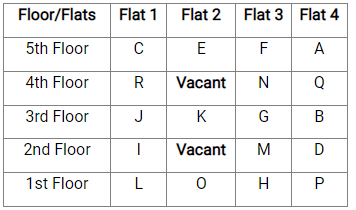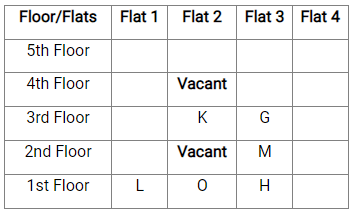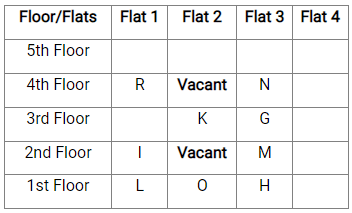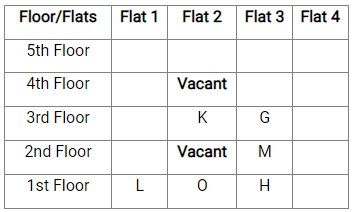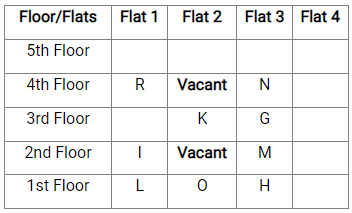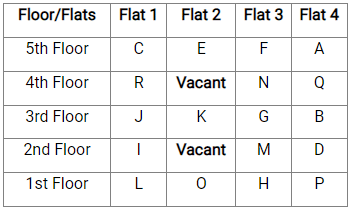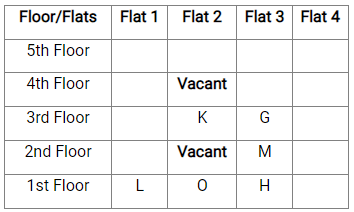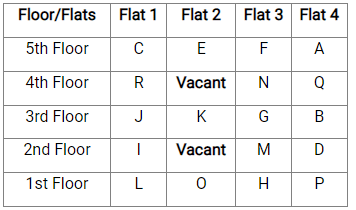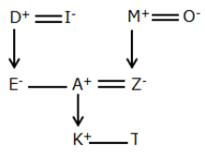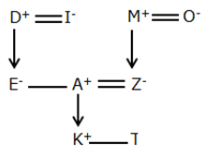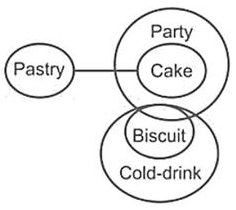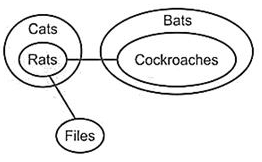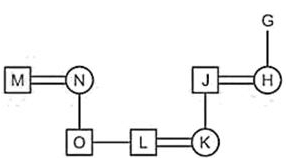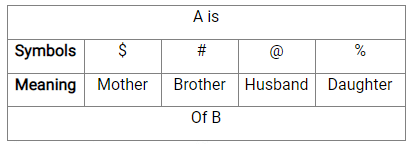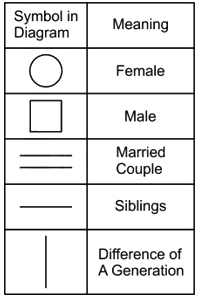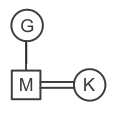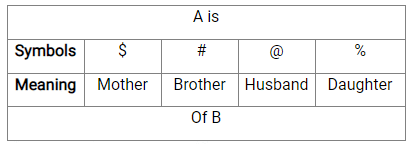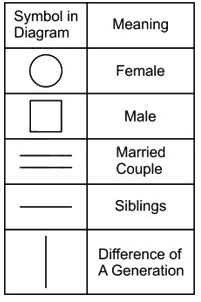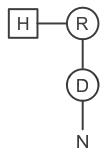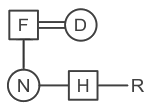IBPS RRB Clerk Mains Mock Test - 1 - Bank Exams MCQ
30 Questions MCQ Test - IBPS RRB Clerk Mains Mock Test - 1
If all the letters of the following words are changed to the second successive letter and arrange the letters in alphabetical order within the word, then how many words have more than one vowel that is immediately followed by consonants?
I. NOSTALGIC
II. EMPOWER
III. REMAND
If all the digits are arranged in the descending order from left to right within each number given below, after changing all the odd digits to the previous digit as per the number series, then what will be the sum of the squares of the first digit of the first number and the third digit of the second number from the left end?
I. 23556789876
II. 987654325678
Study the following information carefully and answer the questions given below.
Person X starts walking from point B towards east and walks for 10m to reach point F then he turns to the right and walks for 15m to reach point K where he turns to the left and walks for 7m to reach point Y where he turns to the left and walks for 8m to reach point S.
Person Y starts walking from point G towards north and walks for 4m to reach point Z then he turns to the left and walks for 5m to reach point J where he turns to the left and walks for 11m to reach point R then he turns to the left and walks for 10m to reach point S.
Q. If point U is 8m south of point R, then what is the direction and distance of point Y with respect to point U?
Study the following information carefully and answer the questions given below.
Person X starts walking from point B towards east and walks for 10m to reach point F then he turns to the right and walks for 15m to reach point K where he turns to the left and walks for 7m to reach point Y where he turns to the left and walks for 8m to reach point S.
Person Y starts walking from point G towards north and walks for 4m to reach point Z then he turns to the left and walks for 5m to reach point J where he turns to the left and walks for 11m to reach point R then he turns to the left and walks for 10m to reach point S.
Q. What is the shortest distance between point J and point F?
Study the following information carefully and answer the questions given below.
Person X starts walking from point B towards east and walks for 10m to reach point F then he turns to the right and walks for 15m to reach point K where he turns to the left and walks for 7m to reach point Y where he turns to the left and walks for 8m to reach point S.
Person Y starts walking from point G towards north and walks for 4m to reach point Z then he turns to the left and walks for 5m to reach point J where he turns to the left and walks for 11m to reach point R then he turns to the left and walks for 10m to reach point S.
Q. If point N is north of point B and west of point J, then what is the distance between point Z and point N?
Direction: Study the information given below carefully and answer the questions that follow.
Eighteen persons A-R live in a building with five floors. Each floor has 4 flats – flat-1, flat-2, flat-3, and flat-4 from left to right such that flat-1 is the leftmost flat and flat -4 is the rightmost flat. The ground floor is numbered as 1 and the topmost floor is numbered as 5. Each flat is built in such a way that flat-1 of floor 2 is just above the flat 1 of floor 1 and so on. Flat-1, 3 are odd-numbered while Flat-2, 4 are even-numbered.
Note:
1. Each flat is of the same dimensions. The two flats in which no one lives are on an even-numbered floor and an even-numbered flat.
2. If a person lives in the flat, which is just above the flat of another person, then, both live in the same numbered flat.
B’s floor and the flat are immediately above the D’s floor and flat. C’s flat and K's flat numbers are not the same. N and O do not live in flat 4. G does not live on an even-numbered floor and even-numbered flat. E and C do not live on the third floor. M lives on a floor and flat just above on the floor and flat of H. The flat between K and O is vacant and K lives in one of the flats above O. Flat 4 of every floor is occupied. Q lives on one of the floors above P but does not live on the topmost floor. L lives in an odd-numbered flat which is on the left of O. R and N live on the same floor and only one more person lives with them on that floor. G lives on the floor and flat just above the M’s floor and flat. I live on one of the floors on which one flat is vacant. R and I both live in flat 1. F lives on a floor and flat just above N’s floor and flat. K and G do not live on the fifth floor. Two persons live between Q and P in the same numbered flat. A live on the fifth floor but does not live above the vacant flat and immediately above R.
Q. Who lives just above R in the same flat number?
Direction: Study the information given below carefully and answer the questions that follow.
Eighteen persons A-R live in a building with five floors. Each floor has 4 flats – flat-1, flat-2, flat-3, and flat-4 from left to right such that flat-1 is the leftmost flat and flat -4 is the rightmost flat. The ground floor is numbered as 1 and the topmost floor is numbered as 5. Each flat is built in such a way that flat-1 of floor 2 is just above the flat 1 of floor 1 and so on. Flat-1, 3 are odd-numbered while Flat-2, 4 are even-numbered.
Note:
1. Each flat is of the same dimensions. The two flats in which no one lives are on an even-numbered floor and an even-numbered flat.
2. If a person lives in the flat, which is just above the flat of another person, then, both live in the same numbered flat.
B’s floor and the flat are immediately above the D’s floor and flat. C’s flat and K's flat numbers are not the same. N and O do not live in flat 4. G does not live on an even-numbered floor and even-numbered flat. E and C do not live on the third floor. M lives on a floor and flat just above on the floor and flat of H. The flat between K and O is vacant and K lives in one of the flats above O. Flat 4 of every floor is occupied. Q lives on one of the floors above P but does not live on the topmost floor. L lives in an odd-numbered flat which is on the left of O. R and N live on the same floor and only one more person lives with them on that floor. G lives on the floor and flat just above the M’s floor and flat. I live on one of the floors on which one flat is vacant. R and I both live in flat 1. F lives on a floor and flat just above N’s floor and flat. K and G do not live on the fifth floor. Two persons live between Q and P in the same numbered flat. A live on the fifth floor but does not live above the vacant flat and immediately above R.
Q. Who lives two places above P in the same flat number?
Direction: Study the information given below carefully and answer the questions that follow.
Eighteen persons A-R live in a building with five floors. Each floor has 4 flats – flat-1, flat-2, flat-3, and flat-4 from left to right such that flat-1 is the leftmost flat and flat -4 is the rightmost flat. The ground floor is numbered as 1 and the topmost floor is numbered as 5. Each flat is built in such a way that flat-1 of floor 2 is just above the flat 1 of floor 1 and so on. Flat-1, 3 are odd-numbered while Flat-2, 4 are even-numbered.
Note:
1. Each flat is of the same dimensions. The two flats in which no one lives are on an even-numbered floor and an even-numbered flat.
2. If a person lives in the flat, which is just above the flat of another person, then, both live in the same numbered flat.
B’s floor and the flat are immediately above the D’s floor and flat. C’s flat and K's flat numbers are not the same. N and O do not live in flat 4. G does not live on an even-numbered floor and even-numbered flat. E and C do not live on the third floor. M lives on a floor and flat just above on the floor and flat of H. The flat between K and O is vacant and K lives in one of the flats above O. Flat 4 of every floor is occupied. Q lives on one of the floors above P but does not live on the topmost floor. L lives in an odd-numbered flat which is on the left of O. R and N live on the same floor and only one more person lives with them on that floor. G lives on the floor and flat just above the M’s floor and flat. I live on one of the floors on which one flat is vacant. R and I both live in flat 1. F lives on a floor and flat just above N’s floor and flat. K and G do not live on the fifth floor. Two persons live between Q and P in the same numbered flat. A live on the fifth floor but does not live above the vacant flat and immediately above R.
Q. How many persons live between the flats of H and F (in the same flat number)?
Direction: Study the information given below carefully and answer the questions that follow.
Eighteen persons A-R live in a building with five floors. Each floor has 4 flats – flat-1, flat-2, flat-3, and flat-4 from left to right such that flat-1 is the leftmost flat and flat -4 is the rightmost flat. The ground floor is numbered as 1 and the topmost floor is numbered as 5. Each flat is built in such a way that flat-1 of floor 2 is just above the flat 1 of floor 1 and so on. Flat-1, 3 are odd-numbered while Flat-2, 4 are even-numbered.
Note:
1. Each flat is of the same dimensions. The two flats in which no one lives are on an even-numbered floor and an even-numbered flat.
2. If a person lives in the flat, which is just above the flat of another person, then, both live in the same numbered flat.
B’s floor and the flat are immediately above the D’s floor and flat. C’s flat and K's flat numbers are not the same. N and O do not live in flat 4. G does not live on an even-numbered floor and even-numbered flat. E and C do not live on the third floor. M lives on a floor and flat just above on the floor and flat of H. The flat between K and O is vacant and K lives in one of the flats above O. Flat 4 of every floor is occupied. Q lives on one of the floors above P but does not live on the topmost floor. L lives in an odd-numbered flat which is on the left of O. R and N live on the same floor and only one more person lives with them on that floor. G lives on the floor and flat just above the M’s floor and flat. I live on one of the floors on which one flat is vacant. R and I both live in flat 1. F lives on a floor and flat just above N’s floor and flat. K and G do not live on the fifth floor. Two persons live between Q and P in the same numbered flat. A live on the fifth floor but does not live above the vacant flat and immediately above R.
Q. Who among the following lives with I on the same floor?
Direction: Study the information given below carefully and answer the questions that follow.
Eighteen persons A-R live in a building with five floors. Each floor has 4 flats – flat-1, flat-2, flat-3, and flat-4 from left to right such that flat-1 is the leftmost flat and flat -4 is the rightmost flat. The ground floor is numbered as 1 and the topmost floor is numbered as 5. Each flat is built in such a way that flat-1 of floor 2 is just above the flat 1 of floor 1 and so on. Flat-1, 3 are odd-numbered while Flat-2, 4 are even-numbered.
Note:
1. Each flat is of the same dimensions. The two flats in which no one lives are on an even-numbered floor and an even-numbered flat.
2. If a person lives in the flat, which is just above the flat of another person, then, both live in the same numbered flat.
B’s floor and the flat are immediately above the D’s floor and flat. C’s flat and K's flat numbers are not the same. N and O do not live in flat 4. G does not live on an even-numbered floor and even-numbered flat. E and C do not live on the third floor. M lives on a floor and flat just above on the floor and flat of H. The flat between K and O is vacant and K lives in one of the flats above O. Flat 4 of every floor is occupied. Q lives on one of the floors above P but does not live on the topmost floor. L lives in an odd-numbered flat which is on the left of O. R and N live on the same floor and only one more person lives with them on that floor. G lives on the floor and flat just above the M’s floor and flat. I live on one of the floors on which one flat is vacant. R and I both live in flat 1. F lives on a floor and flat just above N’s floor and flat. K and G do not live on the fifth floor. Two persons live between Q and P in the same numbered flat. A live on the fifth floor but does not live above the vacant flat and immediately above R.
Q. Which of the following is true?
Study the following information carefully and answer the questions given below.
A family consists of nine members with three generations and three married couples. E is the sister-in-law of Z, who does not have any siblings. D is the father-in-law of Z. K is the grandson of Z’s mother-in-law. Only one child of D is married. M is the father-in-law of A, who is the father of K. I is the mother-in-law of T’s mother. O is the grandmother of T.
Q. How T is related to M?
Study the following information carefully and answer the questions given below.
A family consists of nine members with three generations and three married couples. E is the sister-in-law of Z, who does not have any siblings. D is the father-in-law of Z. K is the grandson of Z’s mother-in-law. Only one child of D is married. M is the father-in-law of A, who is the father of K. I is the mother-in-law of T’s mother. O is the grandmother of T.
Q. If U is the Spouse of K, then how U is related to Z?
Study the following information carefully and answer the questions given below.
A family consists of nine members with three generations and three married couples. E is the sister-in-law of Z, who does not have any siblings. D is the father-in-law of Z. K is the grandson of Z’s mother-in-law. Only one child of D is married. M is the father-in-law of A, who is the father of K. I is the mother-in-law of T’s mother. O is the grandmother of T.
Q. How E is related to I?
Direction: In the question below are given four statements followed by four conclusions numbered I, II, III and IV. You have to take the given statements to be true even if they seem to be at variance with commonly known facts. Read all the conclusions and then decide which of the given conclusions logically follows from the given statements disregarding commonly known facts.
Statements:
No Pastry is Cake
All Cake is Party
Some Party are Biscuit
All Biscuit are Cold drink
Conclusions:
I. Some Pastry are Cold drink
II. Some Party is Cold drink
III. Some Cake is Cold drink
IV. Some Biscuit is Cake
Direction: In the question below are given four statements followed by four conclusions numbered I, II, III and IV. You have to take the given statements to be true even if they seem to be at variance with commonly known facts. Read all the conclusions and then decide which of the given conclusions logically follows from the given statements disregarding commonly known facts.
Statements:
Only few cup are Brown
Only a few brown are tea
100% of tea is milk
No cup is beans
Conclusions:
I. Some milk are brown
II. No cup is tea
III. Some cup are tea
IV. No milk are beans
Direction: In the question below are given four statements followed by four conclusions numbered I, II, III and IV. You have to take the given statements to be true even if they seem to be at variance with commonly known facts. Read all the conclusions and then decide which of the given conclusions logically follows from the given statements disregarding commonly known facts.
Statements:
No rats are Cockroaches
No flies are Rats
All Cockroaches are Bats
All Rats are Cats
Conclusions:
I. All Bats are Flies
II. No Cats are Flies
III. Some Flies are Cats
IV. Some Cats are Bats
Study the following information carefully and answer the questions given below.
Words arrangement machine when given an input line of numbers rearranges them following a particular rule in each step. The following is an illustration of input and rearrangement.
Input: Entry Occur Relay Idiom Hound Ready Globe
Step I: Relay Entry Occur Idiom Hound Ready Globe
Step II: Relay Globe Entry Occur Idiom Hound Ready
Step III: Relay Globe Ready Entry Occur Idiom Hound
Step IV: Relay Globe Ready Hound Entry Occur Idiom
Step V: Relay Globe Ready Hound Idiom Entry Occur
Step V is the last step
Input: Reign Flame Proxy Leave Fetch Label Pedal
Q. How many words are there in between “Fetch” and “Proxy” in step II?
Study the following information carefully and answer the questions given below.
Words arrangement machine when given an input line of numbers rearranges them following a particular rule in each step. The following is an illustration of input and rearrangement.
Input: Entry Occur Relay Idiom Hound Ready Globe
Step I: Relay Entry Occur Idiom Hound Ready Globe
Step II: Relay Globe Entry Occur Idiom Hound Ready
Step III: Relay Globe Ready Entry Occur Idiom Hound
Step IV: Relay Globe Ready Hound Entry Occur Idiom
Step V: Relay Globe Ready Hound Idiom Entry Occur
Step V is the last step
Input: Reign Flame Proxy Leave Fetch Label Pedal
Q. Which of the following word is third to the left of the fifth word from the left end in Step III?
Study the following information carefully and answer the questions given below.
Words arrangement machine when given an input line of numbers rearranges them following a particular rule in each step. The following is an illustration of input and rearrangement.
Input: Entry Occur Relay Idiom Hound Ready Globe
Step I: Relay Entry Occur Idiom Hound Ready Globe
Step II: Relay Globe Entry Occur Idiom Hound Ready
Step III: Relay Globe Ready Entry Occur Idiom Hound
Step IV: Relay Globe Ready Hound Entry Occur Idiom
Step V: Relay Globe Ready Hound Idiom Entry Occur
Step V is the last step
Input: Reign Flame Proxy Leave Fetch Label Pedal
Q. In which of the following steps “Proxy Leave Label” is obtained in the same sequence for the first time?
Study the following information carefully and answer the questions given below.
Words arrangement machine when given an input line of numbers rearranges them following a particular rule in each step. The following is an illustration of input and rearrangement.
Input: Entry Occur Relay Idiom Hound Ready Globe
Step I: Relay Entry Occur Idiom Hound Ready Globe
Step II: Relay Globe Entry Occur Idiom Hound Ready
Step III: Relay Globe Ready Entry Occur Idiom Hound
Step IV: Relay Globe Ready Hound Entry Occur Idiom
Step V: Relay Globe Ready Hound Idiom Entry Occur
Step V is the last step
Input: Reign Flame Proxy Leave Fetch Label Pedal
Q. Which of the following word is second to the left of “Proxy” in Step IV?
Directions: Study the following information carefully and answer the questions follows:
Seven people – A, C, E, P, R, T and U are sitting in a single row (not necessarily in the same order). Only three people are facing towards north and rest are facing south. Each of them likes different colours – Red, Blue, Green, Violet, Brown, Pink and White. The one who likes red is sitting fifth from the right end of the row. Only one person is sitting between R and the one who likes red. The one who likes green is sitting third to the left of R. The one who likes violet is an immediate neighbour of the one who likes green. A doesn’t like red but is sitting second to the right of the one who likes violet. U is an immediate neighbour of A and both are facing the opposite direction. The one who likes blue is sitting fourth to the left of U.E doesn’t like blue. The one who likes brown is sitting fourth to the left of E. E is sitting third to the right of C. P is sitting fourth to the right of the one who likes white.
Q. Who among the following likes Green?
Directions: Study the following information carefully and answer the questions follows:
Seven people – A, C, E, P, R, T and U are sitting in a single row (not necessarily in the same order). Only three people are facing towards north and rest are facing south. Each of them likes different colours – Red, Blue, Green, Violet, Brown, Pink and White. The one who likes red is sitting fifth from the right end of the row. Only one person is sitting between R and the one who likes red. The one who likes green is sitting third to the left of R. The one who likes violet is an immediate neighbour of the one who likes green. A doesn’t like red but is sitting second to the right of the one who likes violet. U is an immediate neighbour of A and both are facing the opposite direction. The one who likes blue is sitting fourth to the left of U.E doesn’t like blue. The one who likes brown is sitting fourth to the left of E. E is sitting third to the right of C. P is sitting fourth to the right of the one who likes white.
Q. Who among the following is not facing towards south?
Directions: Study the following information carefully and answer the questions follows:
Seven people – A, C, E, P, R, T and U are sitting in a single row (not necessarily in the same order). Only three people are facing towards north and rest are facing south. Each of them likes different colours – Red, Blue, Green, Violet, Brown, Pink and White. The one who likes red is sitting fifth from the right end of the row. Only one person is sitting between R and the one who likes red. The one who likes green is sitting third to the left of R. The one who likes violet is an immediate neighbour of the one who likes green. A doesn’t like red but is sitting second to the right of the one who likes violet. U is an immediate neighbour of A and both are facing the opposite direction. The one who likes blue is sitting fourth to the left of U.E doesn’t like blue. The one who likes brown is sitting fourth to the left of E. E is sitting third to the right of C. P is sitting fourth to the right of the one who likes white.
Q. Four of the following five options are alike in a certain way, find out the odd pair?
Directions: Study the following information carefully and answer the questions follows:
Seven people – A, C, E, P, R, T and U are sitting in a single row (not necessarily in the same order). Only three people are facing towards north and rest are facing south. Each of them likes different colours – Red, Blue, Green, Violet, Brown, Pink and White. The one who likes red is sitting fifth from the right end of the row. Only one person is sitting between R and the one who likes red. The one who likes green is sitting third to the left of R. The one who likes violet is an immediate neighbour of the one who likes green. A doesn’t like red but is sitting second to the right of the one who likes violet. U is an immediate neighbour of A and both are facing the opposite direction. The one who likes blue is sitting fourth to the left of U.E doesn’t like blue. The one who likes brown is sitting fourth to the left of E. E is sitting third to the right of C. P is sitting fourth to the right of the one who likes white.
Q. Who among the following is/are sitting at the extreme ends?
If all the consonants before 'M' (in alphabet series) of the word "CONSIDERATION" are changed to their immediately succeeding letters (as per alphabet series) and all the consonants after 'M' (in alphabet series) of the same word are changed to their immediately preceding letters (as per alphabet series) then what is the exactly middle letter of the meaningful english (singular) word formed from third, fourth, sixth, ninth and tenth letters of the changed word?
Direction: Study the information given below carefully and answer the question that follow.
A boy starts from a point P and walks 6 km towards south to reach point Q. He takes a left turn and walks 3 km to reach point R. He takes a left turn again and walks 12 km to reach point S. From there he takes left turn and walks 6 km and reaches point T. He takes a left turn again and walks another 6 km to reach point U. He takes a left turn and walks 5 km to reach point V.
Q. Distance between the midpoint of S and R and point U is?
Direction: Study the following information carefully to answer the given questions:
If ‘A ¥ B’ means ‘A is the mother of B’
If ‘A € B’ means ‘A is the sister of B’
If ‘A $ B’ means ‘A is the father of B’
If ‘A # B’ means ‘A is the brother of B’
If ‘A % B’ means ‘A is the daughter of B’
If ‘A © B’ means ‘A is the grandfather of B’
If ‘A & B’ means ‘A is the husband of B’
If ‘A * B’ means ‘A is the wife of B’
If ‘A ^ B’ means ‘A is the son of B’
If ‘A @ B’ means ‘A is the grandmother of B’
Q. How is L related to H in the following expression?
M & N ¥ O # L & K % J & H % G
Directions: Study the following information carefully and answer the questions given below:
‘A $ B’ means A is the mother of B.
‘A # B’ means A is the brother of B.
‘A @ B’ means A is the husband of B.
‘A % B’ means A is the daughter of B.
Q. If 'G $ M @ K', how is K related to G?
Directions: Study the following information carefully and answer the questions given below:
‘A $ B’ means A is the mother of B.
‘A # B’ means A is the brother of B.
‘A @ B’ means A is the husband of B.
‘A % B’ means A is the daughter of B.
Q. Which of the following indicates H is the brother of N?
Direction: A statement is given followed by two conclusions numbered I and II. You have to assume everything in the statement to be true and then consider the two conclusions together to decide which of them logically follows.
Statement: It is unhealthy to keep plants in bedrooms, especially at nights. Due to the excess carbon dioxide produced during those hours, it can lead to suffocation.
Conclusions:
I: We should not grow plants at home.
II: Plants need to be placed in outer spaces like windows or balconies.



